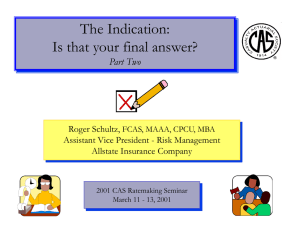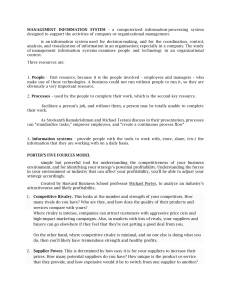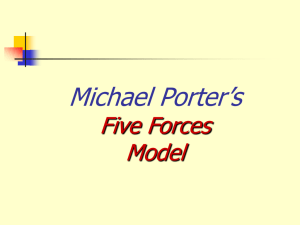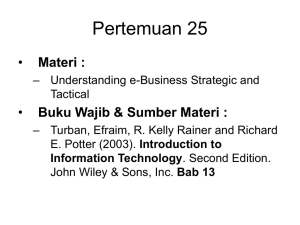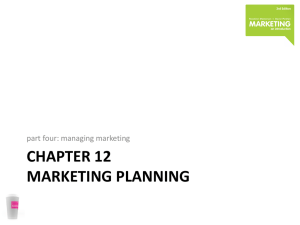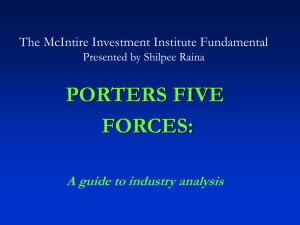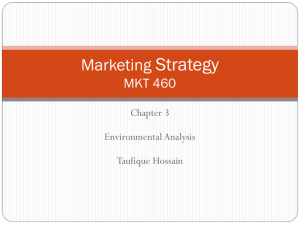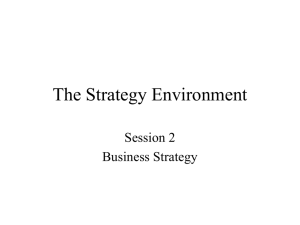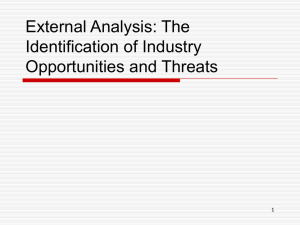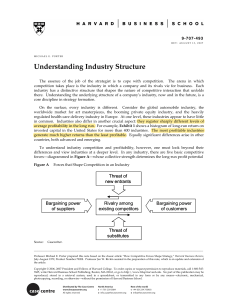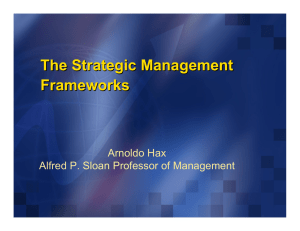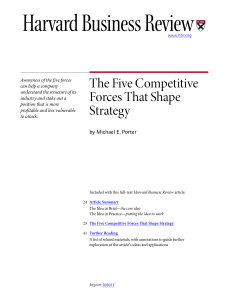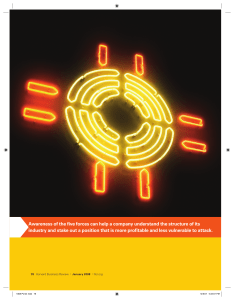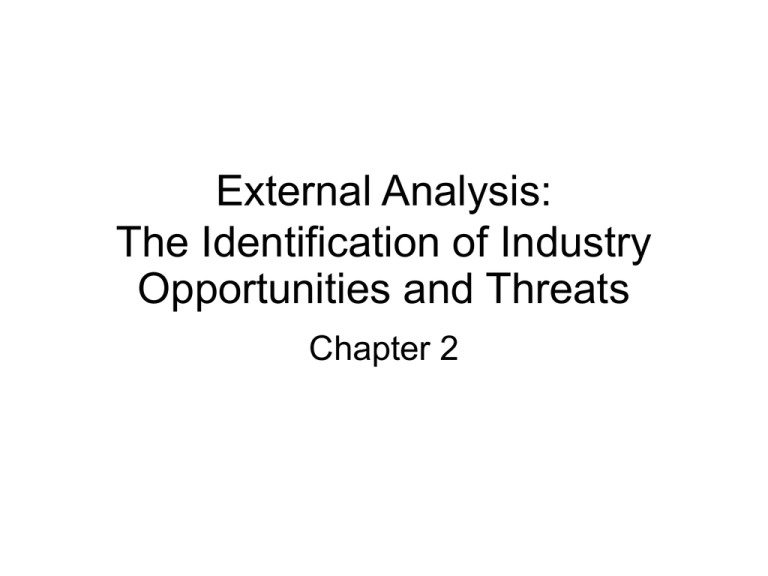
External Analysis:
The Identification of Industry
Opportunities and Threats
Chapter 2
External Analysis
• Analyzing the dynamics of the industry in
which an organization competes to help
identify:
– Opportunities: conditions in the environment
that a company can take advantage of to
become more profitable
– Threats: conditions in the environment that
endanger the integrity and profitability of the
company’s business
Defining an Industry
• Industry
– A group of companies offering products or
services that are close substitutes for each
other
• Competitors
– Rival companies that serve the same basic
customer needs
Defining an Industry (cont’d)
• Sector
– A group of closely related industries
• Market segments
– Distinct groups of customers within a market
that can be differentiated from each other
based on their distinct attributes and demands
• Changing industry boundaries
The Computer Sector:
Industries and Segments
The Computer Sector
Where is the customer?
The Computer Sector:
Industries and Segments
Strategic Groups Within
Industries
•
•
Formed within an industry when some
companies follow the same basic product
positioning strategy, which is different
from that of other companies in other
groups
Companies can position their products in
terms of distribution channels, market
segments, product quality, technological
leadership, customer service, pricing
policy, advertising policy, promotions
Strategic Groups in the
Pharmaceutical Industry
Insert Figure 2.3
Implications of Strategic Groups
• A company’s closest competitors are those
in its strategic group
• Each strategic group may face a different
set of opportunities and threats
The Role of Mobility Barriers
• A company may decide to move from one
strategic group to another where the five
forces are weaker and higher profits are
possible
• Mobility barriers are similar to industry
entry and exit barriers and must be
weighed carefully
Industry Analysis:
Background
• Industrial economics: focus on “common
good” or competitive pricing
• Selected measures of competition (high, if)
– Level of concentration (low)
• Concentration – percent of total sales controlled by
largest 4, 8, 12 players in the industry
– Presence of economies of scale (high)
– Product differentiation (low)
– Natural barriers, i.e. fixed supply (low)
Porter’s Five Forces Model
Source: Adapted and reprinted by permission of Harvard Business Review. From “How Competitive
Forces Shape Strategy,” by Michael E. Porter, Harvard Business Review, March/April 1979 © by the
President and Fellows of Harvard College. All rights reserved.
Porter’s Five Forces Model
• An industry is competitive (if . . .)
– Risk of entry (high, low barriers)
– Intensity of Rivalry (high)
– Bargaining power of buyers (high)
– Bargaining power of suppliers (high)
– Presence of substitute products (yes)
• Complementors added later
Risk of Entry
• Natural barriers - oil fields, mines
• Barriers created over time –
– Brand loyalty (due to advertising, etc.)
– Cost advantage (due to cheap funds, control
of inputs, production)
– Economies of scale (production and
distribution susceptible to scale economies)
– Switching costs (microsoft to apple, oil to coal)
– Regulation
Intensity of Rivalry:
Industry characteristics
• Industry demand
– Is long-term demand growing? stagnant?
declining?
• Exit barriers
– Cost of shutting down business and/or moving
to another.
Intensity of Rivalry:
Due to industry structure
• Fragmented (large number of competitors)
– retailing
• Consolidated (4, 8, 12 competitors control
80% of the industry)
– cement
• Monopoly
– AT&T before the break-up
Power of Buyers:
High if . . .
• Numerous participants selling to few
buyers
• Buyers purchase large quantities
• Participants depend on a set of buyers for
a large percent of their business
• Buyers have low switching costs
• Buyers can purchase from more than one
• Buyers can threaten to enter the industry
Power of Suppliers:
High if . . .
• Product of suppliers few substitutes
• Profitability of supplier not dependent on
industry purchases
• Industry has switching cost problems if
they move to a new set of suppliers
• Suppliers can threaten to enter
• Industry can not threaten to enter
suppliers’ industry
Substitutes
• Distinction between competing and
substitute products
– Coke and Pepsi are not substitutes; they are
close substitutes but not within this definition
– Coffee is a substitute for tea or caffeine drink
– Substitute for a car when going to Las Vegas?
San Francisco?
– Substitute for a computer?
Complementors
• Adds value to an industry’s products
– Software industry and computer industry
• Others:
– Hotel and airlines
– Malls will group movies and restaurants in
same sector of the mall
– Mobile phones and developers of messages
to be texted
Industry Life Cycle Analysis
• The strength and nature of the five forces
change as an industry evolves through its
life cycle
• Managers must anticipate how the forces
will change as the industry evolves and
formulate appropriate strategies
Stages in the Industry Life Cycle
Industry Life Cycle
• Addresses industry demand (intensity of
rivalry)
• Emergence of industry standard normally
propels industry into growth phase
– At the development or embryonic phase,
different configurations compete
– As a standard emerges, industry demand
goes through a period of higher rate of growth
Shakeout: Growth in Demand
and Capacity
Limitations of Models for
Industry Analysis
• Life cycle issues
– The embryonic stage can sometimes be
skipped or short
– Industry growth can be revitalized
– The time span of the stages can vary
• Innovation and change
– Innovation can unfreeze and reshape industry
structure
– An industry may be hypercompetitive, with
permanent and ongoing change
Limitations of Models for
Industry Analysis (cont’d)
• Company differences
– The importance of company differences
within an industry or strategic group can
be underemphasized
– The individual resources and
capabilities of a company may be more
important in determining profitability
than the industry or strategic group
Exercise:
Strategy in Action
• 2.1 Japanese Brewing Industry:
– What were key barriers to entry into industry?
– How did these change and what remained to
be barriers for, say, an American brewer?
• 2.2 Breakfast Cereal Industry:
– Why was it necessary for pricing discipline to
emerge?
– Are consumers better off?
The Role of the
Macroenvironment
Rate of change?
•
•
•
•
•
•
Economic indicators – interest rates, etc.
Technological changes
Political/Regulatory
Demographic changes
Social forces
Are these in some order?
The Global and National
Environments
• Globalization of production and markets
– Lower barriers to cross-border trade and
investment
– National differences in the cost and quality of
factors of production
– “Home” and “foreign” markets and
competitors are blurring
– Intensified rivalry
– Intensified rate of innovation
– Many new markets are open
Additional Thoughts
• “Multi-nation” and “Global”
• Factor conditions, industry structure in other
countries allow for innovation
• These innovation often travel across borders
– The internet is obviously one reason
– Personal travel
– Companies finding limited growth options at home
• Entry barriers
– Tariff
– Non-tariff
National and Competitive
Advantage
Source: Adapted from M.E. Porter, “The Competitive Advantage of Nations,” Harvard Business Review,
March-April, 1990, p. 77.

